ASUS Transformer Book T100 Review: Redefining the Entry-Level Windows Notebook
by Anand Lal Shimpi on October 18, 2013 12:00 AM ESTDisplay
The T100 features a 10.1-inch 1366 x 768 IPS display, which makes for awesome viewing angles and an experience that will put most entry level notebooks to shame. Compared to what we’re used to seeing from Windows notebooks, ASUS did a tremendous job with the panel selection given the price of the T100.
Brightness, black levels and contrast are all reasonable but nothing extraordinary. Max brightness in particular is limited to only 228 nits. That’s more than bright enough for indoor use, but outdoors or in direct sunlight you may wish for a brighter panel. Black levels are quite good, which helps deliver great contrast ratio. As I mentioned at the beginning of the article, the gap between display panel and cover glass is large enough that reflections can be an issue - a problem that is worsened by the fact that the panel can’t get super bright.
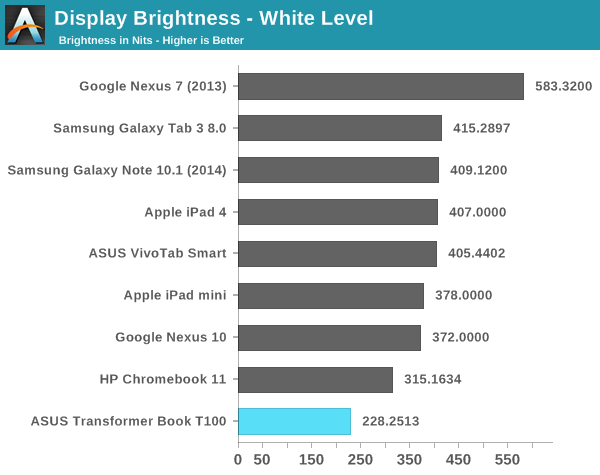
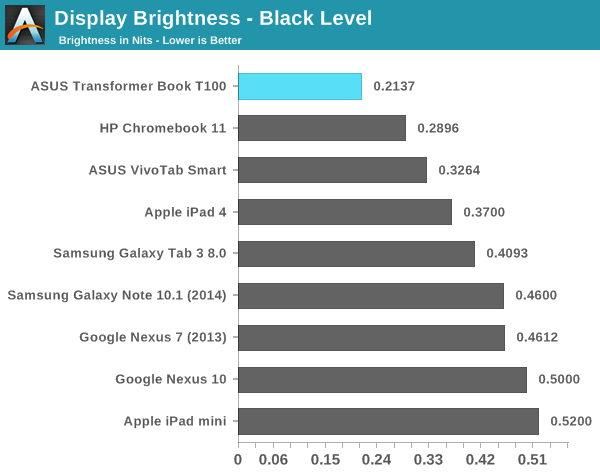

Whether or not any of this is a problem to you really depends on perspective. If we’re limiting our comparison to traditional entry level PC notebooks then ASUS has really redefined what it means to be a $349 PC. If you broaden the comparison to Android tablets and even Chromebooks, the comparison grows more difficult.
Color accuracy isn’t great on the T100. Once again, compared to what you’d traditionally get from a Wintel PC at this price point it’s amazing. Compared to the Chromebook 11 we recently reviewed at $279 however, the T100 needs some work.
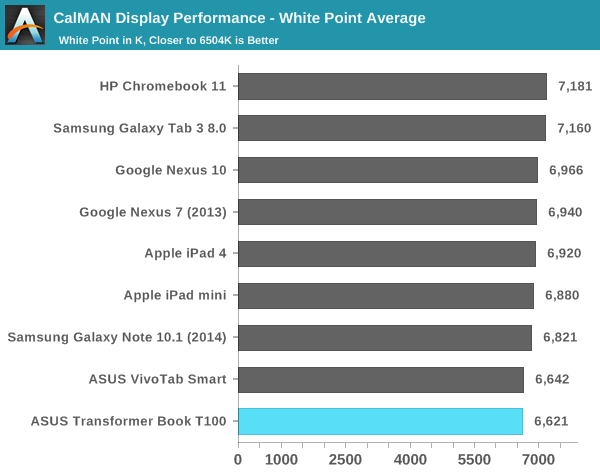
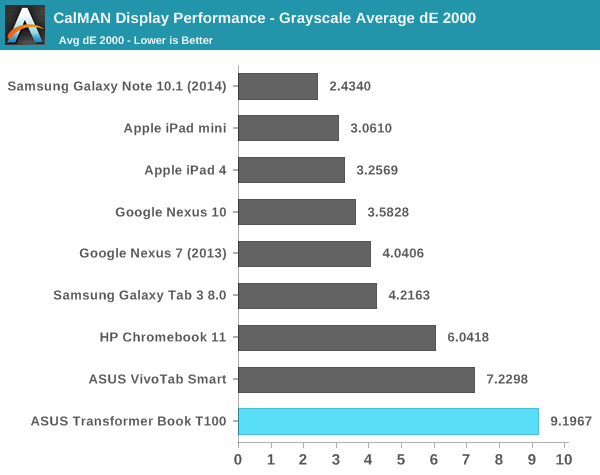
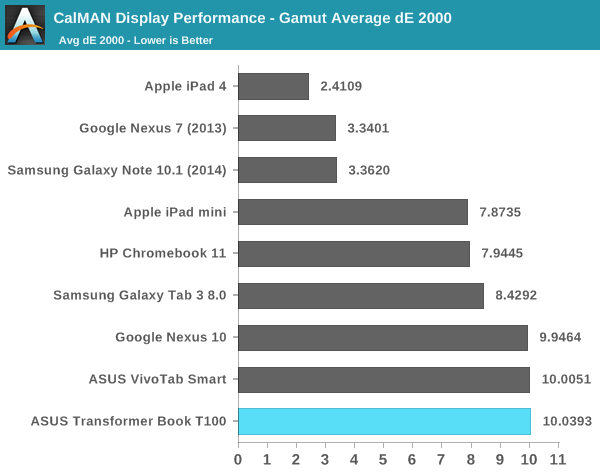

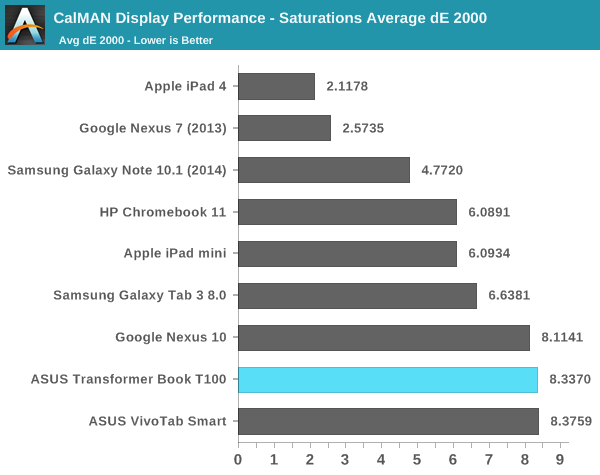



It’s definitely not a bad display, it just doesn’t live up to the expectations of some other low cost devices we’ve seen lately (e.g. 2013 Nexus 7, Chromebook 11). The charts below show you the stark difference between what we're expecting to display and what the T100 actually displays:
There's a green hue to all of the white/grays, and the other colors are just off. Users definitely benefit from the viewing angles of IPS but the T100 needs calibration.













158 Comments
View All Comments
Callitrax - Friday, October 18, 2013 - link
Anand, one issue I have with this review, most of the text approaches the T100 solely as a laptop (paragraphs on the keyboard dock, nothing on balance in hand as a tablet, not one of the gallery images show it detached) Whereas my curiosity in this is as a tablet with occasional laptop functionality. How well does it function as a tablet? Some of the benchmarks help there, but nothing in the Final Words section relevant to that usage mode.azazel1024 - Friday, October 18, 2013 - link
I don't entirely agree. I care about the display quality and the Delta-E does matter to me to a degree. What I would have liked to have heard more was, AFTER calibration, what was the best Delta-E capable.I am planning on using this for light photo editing on the road when I need to travel light, so the display quality does matter a lot. I don't need spot on color or 100% sRGB (I am dissapointed that % of sRGB color gamut was missing from the test), but if after calibration it is still 10+ off that would be dissapointing.
I'd love to spend more money on a higher quality Windows 8.1 tablet, but roughly $500 is still my price ceiling and so far I haven't seen anyone announce a Windows 8.1 tablet, that is dockable, has a microSD card slot is less than 11" in size and is $500 or less. Pretty much just the T100 so far. I'd be more than happy to pay as much as $100 more for a better/higher DPI display, the z3770 and 4GB of RAM and call it a day (as per my earlier comment. 300Mbps capable Wifi would also be nice).
For a $399 64GB dockable tablet, the thing seems pretty nice. It seems like there are areas of improvement and in a generation or two, they might be improved or for more cost in this generation (I'd be suprised if in a few months Asus doesn't come out with a higher level Windows 8.1 dockable tablet, which is maybe why better silicon/memory/display are not checkable options on the T100. It might saved for a T200 or something coming in $100 or more higher in price).
spejr - Friday, October 18, 2013 - link
This is an entry level pad with an keyboard cover, only difference is the hinge. How come this review is so positive? I cant imagine this being a good alternative for either a laptop or a tablet, just too many compromises in the same piece of cheapnes. The only argument is economy, but then again my ThinkPad X61 is still running smooth since 06 so thats not a good argument either as quality is cheaper over time. racing to the bottom with one year of life expectency for each device is not the way to go, with anything.AsusJake - Sunday, October 16, 2016 - link
windows 10 64 bit os on mine only 2 gigs of ram... and runs circles around my 6gig ram quadcore 64 bit vista hp desktop...makken - Saturday, October 19, 2013 - link
Hmm, does anyone know if Asus is planning on making a laptop--i.e., a non-detachable version, of this thing?wrkingclass_hero - Saturday, October 19, 2013 - link
No pictures of it undocked from the keyboard in the gallery?Tams80 - Saturday, October 19, 2013 - link
For those disappointed in this, the Fujitsu Q584 might be of interest.It's not available until December though and will likely come with the usual high price tag. The cheaper ones, the Arrows, are Japan only and on par with the T100.
timon_comment - Saturday, October 19, 2013 - link
Waiting a look in Bay Trail M + SATA, Pleasein Windows x86 OS I dislike the eMMC storage system, it is an execrable design, the heavyweight Windows x86 OS is fully unlike in the lightweight Android OS, Windows needs SATA and PCIe, but Atom Bay Trail T is still no support SATA and PCIe.
Intel actually wanted in Android to compete with ARM processor, does not really want Bay Trail T to help Windows tablet to compete market, because the x86 processor is almost no another competitor! Now is Intel wanted to control the Android market!
timon_comment - Saturday, October 19, 2013 - link
Note,Atom Bay Trail T is still no support SATA and PCIe
markc22 - Saturday, October 19, 2013 - link
Please test any Linux distro on this.